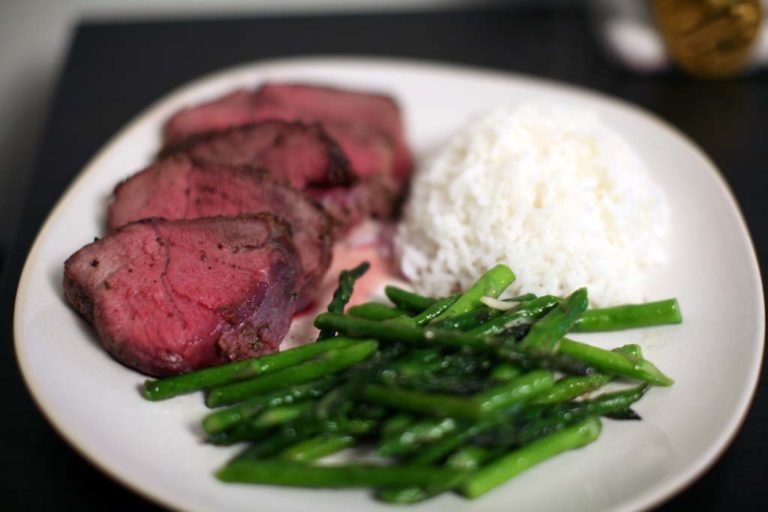
Chef's notes:
Sirloin tip roast does not actually come from the sirloin section of a cow. It comes from the round section directly to the rear of the sirloin section. In its whole, untrimmed form, it is called beef knuckle. Another popular cut of meat comes from the knuckle: the London broil. If you want to buy a whole knuckle and trim it yourself, you will get two for one, plus some extra meat for stew or grinding. I went with the trimmed tip roast to save time.
I have worked with whole beef knuckle at Waldsee German Language Village, a Concordia Language Village. We used the beef knuckle to make rouladen, a thin slice of meat filled with onion, bacon, carrot, pickle, mustard, salt, and pepper. It is quite labor intensive but extremely tasty.
Ingredients
- 1 sirloin tip roast
- Sea salt
- Black pepper
- Oregano leaves
- Vegetable oil
Roast Beef Sirloin Tip with Sea Salt, Vegetable Oil Black Pepper, and Oregano
- Take the roast out of the fridge a few hours before you cook it to get the meat closer to room temperature. A room-temp roast will cook more evenly and quicker than a cold one. Once the roast gets close to room temperature, preheat the oven to 500 degrees F and move the oven racks so you can put the roasting pan on the second rung from the bottom. Season the roast with salt, fresh ground black pepper, and any other seasonings you want. Try to keep it simple. After you have applied your seasonings and rubbed them in, finish the roast by rubbing on some vegetable oil. The oil will help brown the outside and caramelize the meat in a process called the Maillard reaction. Put the roast in the roasting pan and proceed.
- When the oven is up to heat, place the roast in the oven and set the timer for 20 minutes. The first stage of roasting is a high temp for a short period to brown the roast and get some flavor on the outside. Put the roast in quickly and close the door. Set the timer, and don’t open the door until the time is up. Most sirloin tips are around 4 pounds, but if your roast is over 6 pounds, set the timer for 30 minutes instead of 20 minutes.
- When the timer goes off, take the roast out of the oven and lower the heat to 350 degrees F. The second stage of roasting is a low heat to finish the inside of the roast. The best way to make sure your roast is finished to the proper temperature is to use a detachable probe digital thermometer. That way you will be able to monitor the internal temp of the roast as it finishes. Here is the list for temperatures and desired done-ness: rare meat is 120–125 F, medium is 140–150 F, and well done is 160–170 F.
- The last stage of roasting is the resting stage. After you take the meat out of the oven, it will need to cool and rest before it is consumed. The meat juices inside are hot and bubbly, and if you cut into it right now, the juices would run out and leave you with a dry hunk of meat. Let your meat rest for 20 minutes before you cut into it. While the meat rests, cover it with aluminum foil to keep it from getting cold. After it has rested, slice it thinly and against the grain.
Tips & Tricks
- Slow-roasted beef is a long process, but the ends may justify the means on this one. To roast beef slowly, preheat the oven to 250 degrees F. After it is preheated, wait an additional 20 minutes before putting the roast in. Then put the roast in the oven and lower the temp to 200 F. Cook the meat until it gets to 120 degrees F (4–5 hours). Then take it out of the oven and cover it with aluminum foil to keep it warm. Turn the oven up to 500 degrees F. Put the roast back in uncovered, and cook to your desired temp. The last stage gives the outside the caramelized flavor we all like.
- The detachable probe digital thermometer is something that I mention in nearly all of my articles. It is in my opinion one of the most essential kitchen tools that every cook should have. The ability to see the internal temperature of something in the oven without opening the door and taking it out is fantastic. They can be purchased from many places for around 20 dollars.
